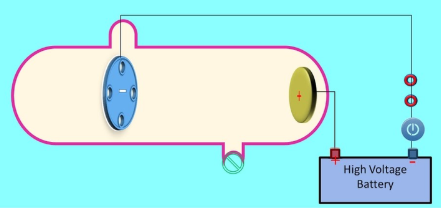The proton was discovered by Ernest Rutherford in 1920 and he was a student of J. J. Thomson. His experiment was based on electrical discharge in the modified cathode ray tubes and it led him to discover the protons. His observations revealed that the particles were charged positively and the rays which carried the positively charged particles are called canal rays. These particles were heavy and their mass order was the same as that of the gaseous molecules or atoms in the tube. Simply, these are the gaseous ions that are positively charged. Unlike electrons, protons are not identical, and their mass varies with the gas being used. The mass of the proton is 1840 times more than the mass of the electron.
Role of Goldstein and Rutherford for Discovery of Proton
At first, the proton was observed in 1886 by Eugen Goldstein. While he was working with the discharge tubes, he observed that rays were traveling from cathode to anode and he also noticed that some waves were traveling in the opposite direction. These waves are anode rays and their e/m ratio is lowest. He stated that these were the characteristics of the gas in the tube. He stated that these are made up of hydrogen ions now named protons.
Discovery Of Proton

After several years, Ernest Rutherford conducted the experiments and revealed that in all of the elements a hydrogen nucleus is present and it proved that all elements do have protons. So, the existence of proton was ultimately verified by Rutherford and majorly credit is given to him and not to the Goldstein.
In his experiment, Rutherford used a thin coil made up of gold which was of micron thickness. Then he bombarded alpha particles on gold foil. At that time, he assumed that most of the space of the atom was empty. However, at that time it was not known that in the center of an atom there are positively charged particles. After analyzing the film of resulting alpha particles which were passing through, he found that some of these particles did not pass and they were reflected. Some of these particles were reflected at acute and some at obtuse angles. Remaining particles which counted a vast majority passed without any deflection. So, he concluded that inside the atom there must be a positive charge. And this is the whole process of how he discovered the proton.
Some main features of protons are as follows.
- The charge to the mass ratio of these positively charged particles depends on the gas which emits them.
- It was found that protons were carrying a multiple of a fundamental unit of electrical charge.
- The behavior of proton in a magnetic or electric field is opposite to the electron.
Experimentally, the existence of protons in the atoms was first proved by the Goldstein followed by Rutherfold. It is based on the observation that atom is electrically neutral so positively charged particles must be present in the atom for neutralization of negative charges of electrons. The existence of proton was confirmed by the production of anode rays.